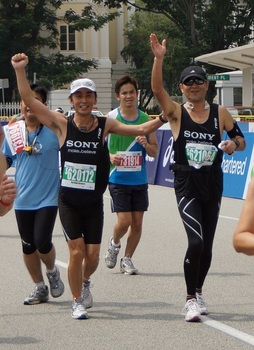Kids at Work [人事5-CSR・健康経営・人事部・労務]
Around 80 kids of our staff were running in our office. They come here every year. This is 3rd time. It is very thoughtful time for me because the young staff who joined our company 20 years ago has become MOM!
China Business Trip [B1.旅行・出張]
My last visit to China is sevral years ago. China is growing at a very high speed. So I visited Shanghai to feel this growth. After Beijin Olympic and Shanghai World Expo, it seems that the growth speed has been stabilized.
Standard Charterd Marathon Singapore 2011 [A1.ランニング]
We reached the start point at Orchard Road before 4;00am. I didn't bring anything to check in because it took a almost one hour to do so last year. However it took forty minitues to use toilet. Again I queued up at the last part of runner.
The runner queued up at the last part are bignner because the order of queuing up is set based on the estimeted finish time.
I planned to start at a slower pace - 7mins/km- since I didn't do the enough training. I began to run with my collegue who challengs his first maraton. There are lots of runners, but VERY SlOW, and some of the were even WALIKNG...
The running pace was 7.5mins/km during the first 10km, we passed 10km point for 1 hour and 15minitues. After that, it beccame less congested, so we could pace up a little bit more, but after passing anther 5km point our pace was coming down. Eventually, we passed 20km points for two and half hours. It means the average pace was still 7.5mins/km!
Then slowly our pace was coming down. I know if I hit the wall before 30km, it would be a disaster and I had to run as an escaping survivor of a defeated army.
The time has come at 28km points ! Oh, Gosh. REALLY SO SOON !? I have asked my body, who relied me - Yes yo didn't train enough!. After 30km - it took 4hours , we had to change to a very slow jog.
Seemed my colluege had a similar situation. His hamstring was problem so he had an even worse situation. When he jogs, his hanstring is pulled with pain.
So he couldn't do even jog. I worried about him so I proposed to walk together. He refused my proposal and let me jog alone.
Worring about him, I decided to jog alone. After 2,3km jog, I found him at the water spot! Yes my jogging pace was same as his walking pace.
So there are no reason to jog or walk individually, we decided to go together. Our pace became 11.5 mins/km.
Finally, we have completed a loooong marathon, which took 6hours and 24 minitues.
I am like this today...
UPHORIA [D1.シンガポール]
We had a big youth event today. Sveral cnsumer campaign were done during this year having a lot of contest and final contests are held in today’s event. Many young people gathered and enjoy the contest and latetst products. We also did the music concert inviting Train and Mike Posner. See big crowds...
2012年資本主義経済大清算の年になる 2012:The Year Capitalism Unravels [D1.政治・経済・社会]

- 作者: 高橋 乗宣
- 出版社/メーカー: 東洋経済新報社
- 発売日: 2011/11/11
- メディア: 単行本





